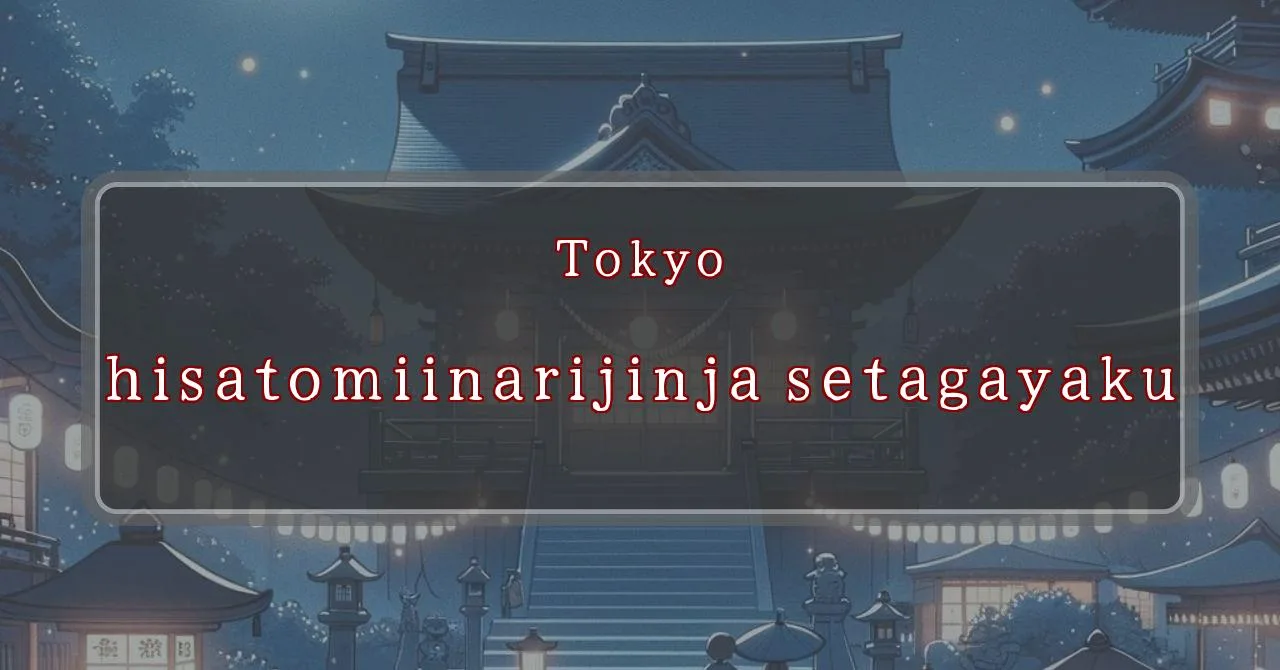Enchanting lanterns illuminate the night at Setagaya’s grand festival
Basic Information
Hisatomi Inari Shrine is a Shinto shrine located in Setagaya Ward, Tokyo, Japan. It is dedicated to the deity Inari, the god of rice and sake.
- Address: 154-0014 Tokyo, Setagaya Ward, Shinmachi 2-17-1
- Phone Number: 03-3425-9871
- Access: 5-minute walk from Sakurashinmachi Station on the Tokyu Den-en-toshi Line
- Festival Days: First Saturday and Sunday of October
Main Events and Attractions of the Festival
The Hisatomi Inari Shrine Festival is a two-day festival held annually on the first Saturday and Sunday of October. The festival features a variety of events and attractions, including:
Mikoshi Procession
On both days of the festival, a mikoshi (portable shrine) procession takes place. The mikoshi is carried through the streets of the neighborhood, accompanied by music and dancing. Participants in the procession wear traditional Japanese clothing, and the atmosphere is lively and festive.
Kagura Performance
Kagura is a traditional Japanese performing art that combines music, dance, and storytelling. During the Hisatomi Inari Shrine Festival, kagura performances are held on both days of the festival. The performances are typically held in the shrine’s main hall, and they tell stories from Japanese mythology and folklore.
Bon Odori Dance
Bon Odori is a traditional Japanese folk dance that is performed during the Obon festival, which is a time to honor the spirits of the dead. During the Hisatomi Inari Shrine Festival, Bon Odori dances are held on both days of the festival. The dances are typically performed in a circle, and participants wear traditional Japanese clothing.
Food and Games
The Hisatomi Inari Shrine Festival also features a variety of food and games. There are food stalls selling traditional Japanese festival foods, such as yakitori (grilled chicken skewers), takoyaki (octopus balls), and kakigori (shaved ice). There are also games for children, such as ring toss and goldfish scooping.
Blessings and Deities
Hisatomi Inari Shrine is dedicated to the deity Inari, the god of rice and sake. Inari is one of the most popular deities in Japan, and is revered for its association with agriculture, fertility, and prosperity. Inari is often depicted as an old man with a long white beard, riding a white fox. The shrine’s main honden (main hall) houses a statue of Inari, as well as statues of the deity’s two attendants, Omiyanome no Mikoto and Sarutahiko no Mikoto.
Origin and History
The exact origins of Hisatomi Inari Shrine are unknown, but it is believed to have been founded in the early Edo period (1603-1868). The shrine was originally located in a different part of Setagaya Ward, but it was moved to its current location in 1931. The shrine’s current honden was built in 1936.
Tips and Notes for Visitors
- The Hisatomi Inari Shrine Festival is held annually on the first Saturday and Sunday of October. The festival features a variety of events and attractions, including a mikoshi procession, kagura performances, Bon Odori dances, and food and games.
- The shrine is open to visitors every day from 9:00 AM to 5:00 PM. Admission is free.
- The shrine is located a 5-minute walk from Sakurashinmachi Station on the Tokyu Den-en-toshi Line.
- There is a small parking lot available for visitors.
Parking Information
There is a small parking lot available for visitors to Hisatomi Inari Shrine. The parking lot is located behind the shrine’s main hall. There is no charge for parking.
Popular Stalls and Food Carts in Recent Years
| Type of Stall | Description |
|---|---|
| Takoyaki | A staple at Japanese festivals. Characterized by a crispy outside and a creamy inside. |
| Jaga Butter | A simple yet popular snack of hot potatoes lavishly topped with melted butter. |
| Baby Castella | Small castella cakes, sweet and fluffy treats enjoyed by children and adults alike. |
| Grilled Ayu with Salt | Fresh ayu fish grilled whole with salt, a savory taste of Japanese summer. |
| Shaapin | A unique gourmet item influenced by foreign cuisine, with a chewy skin wrapping the filling. |
| Okonomiyaki | A Japanese grilled dish where you often choose your own ingredients for a personalized flavor. |
| Cotton Candy | A fluffy, sweet snack that’s extremely popular with children. |
| Chocolate Banana | A banana coated in chocolate, a fun and visually appealing dessert. |
| Kushiyaki | Various types of ingredients skewered and grilled, an easy-to-enjoy snack. |
| Yakisoba | Fried noodles mixed with a special sauce, a fast food favorite in Japan. |



